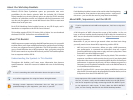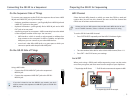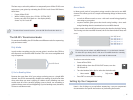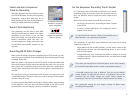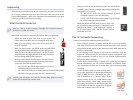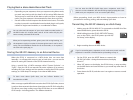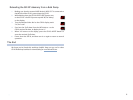
Playing Back a Mono Mode-Recorded Track
Depending on your sequencer, when you sequence using Mono mode,
one track may wind up with the data for all six strings’ MIDI channels.
The best way to work with all this data to split it out onto six separate
tracks. (See your sequencer’s documentation to learn how to do this.)
Set each of the six tracks’ output to the desired sound source. The tracks
can play six sounds in a multitimbral sound module, plug-in soft synths,
a bunch of single-sound modules, or a combination of these.
You can also send the outputs of your mono-mode-recorded tracks to
the GR-20 when it’s in Mono mode, and all of the tracks will play the
same currently selected GR-20 sound.
When you’re sequencing realistic guitar parts with string bending, set
the sequencer to play six copies of the same guitar sound—one for each
string. Use a multitimbral module for all of the sounds, or six copies of
the same soft synth plug-in.
Storing the GR-0’s Memory in an External Device
When the GR-20 is connected to a MIDI device that can store data
internally—on a floppy disk, memory card, or hard drive—you can use the
device for storing the contents of the GR-20’s internal memory.
Using a special form of MIDI messages called “System Exclusive”—or
“SysEx”—data, the GR-20 can transmit the entire contents of its memory,
including all of your settings and User patches, as well as the GR-20’s system
settings, as a “bulk dump” for storage on an external MIDI device.
To learn more about SysEx data, see the InFocus booklet An
Introduction to MIDI.
When a storage-capable MIDI device receives the GR-20’s SysEx data, it saves
it, and can then retransmit the data at a later date to the GR-20 for reloading.
This allows you to keep a safety copy of the GR-20’s data, or to save different
GR-20 setups—including patches—for different situations.
�
�
You can store the GR-20’s SysEx data onto a sequencer track from
where it can be reloaded it into the GR-20 by simply playing the track.
(Make sure your sequencer is set to receive SysEx data.)
Before proceeding, check your MIDI device’s documentation to learn its
procedure for receiving, storing, and transmitting SysEx data.
Transmitting the GR-0’s Memory as a Bulk Dump
Making sure the GR-20’s MIDI OUT is connected to the MIDI IN of the
external MIDI device, power down the GR-20.
While holding down the GR-20’s PATCH EDIT button,
turn on the GR-20—the GR-20 powers up with “dP,”
for “dump,” on the display.
Begin recording data on the MIDI device.
If you’re recording onto a sequencer track, make sure to wait until the
sequencer’s countoff is finished before proceeding to Step 4.
On the GR-20, press the WRITE button to transmit the
GR-20’s SysEx data—during the transmission, the display
shows “t..”
When “dP” returns to the display, the GR-20’s done, so stop recording
on the MIDI device and save the data as you would any other data on
the device.
Power down the GR-20, and then turn it on again to return to normal
operation.
�
�
�
�
�
�




